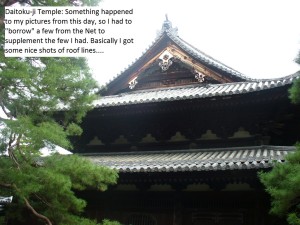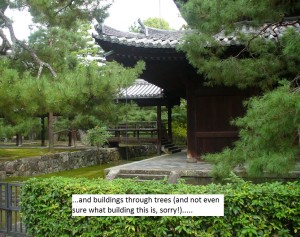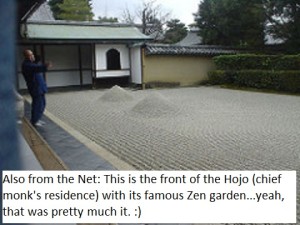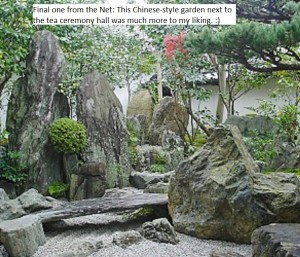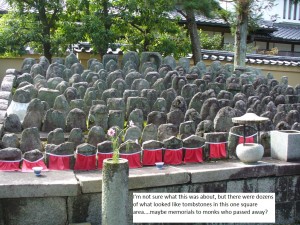
DAY 3
Today we visited the Daitoku-ji temple and gardens. The most adventurous part for me was taking the subway by myself and then a bus (with Mil) to get to the place. I felt ridiculously proud of myself even though I had to ask directions constantly. *LOL*
The Daitoku-ji temple is in Murasaki-no area, which is in the northern part of Kyoto. It is the headquarters of the Daitoku-ji branch of the Rinzai sect of Zen. I’m not sure when it was originally built, but it was a long time ago. Apparently it was completely destroyed by two different fires in the 15th century, and then restored beginning in 1478. Between the 16th and 18th centuries, many more sub-temples (over 80) were built on the property. Then during the Meiji Restoration, anti-Buddhist policies caused most of the buildings to be destroyed, so only about 20 of them are still intact.
The front “garden” is famous for its great scale and elegance that represent Zen spirit. But I have to admit it was too stark for me to appreciate it properly – it just looked like a lot of white gravel and two cone-shaped mounds (also of white gravel)! *g*
There was another garden which was a more to my liking – various bonsai-type plants as well as gravel and a stone bridge – the kind of garden that looks like a miniature landscape. Unfortunately we weren’t allowed to take any pictures of anything (apparently people have been selling them on the internet), so I can’t show you how pretty it was, or even have anything to look back on and remember. But maybe that’s perfectly in keeping with the Zen intent, to be transitory in nature and enjoyed for the moment.
There was a painting on the ceiling of the hatto (lecture hall) of a magnificent dragon, which the guide said represented the guardian spirit of water, in order to protect the building from fire. It was done by Kano Tanyu, who was one of the most celebrated painters in the 17thcentury.
The other thing of note was that we had to sit for a lecture at one point about the structures and garden, but unfortunately it was done entirely in Japanese. Because we couldn’t understand a word, my attention was drawn to the fact that the boards which made up the porch seemed “musical” in nature. They went beyond mere creaking, though it did sound like creaking. They actually seemed to have different tones, and it wasn’t just one or two planks, it was nearly all of them! What was even more amazing to me is that no one else besides me seemed to notice anything unusual! The guide was giving her lecture, and it was constantly punctuated by squeaks and creaks and almost chiming sounds as people walked by. Whether it was intentional or done by weathering was a mystery that was fortunately solved for me when we visited Nijo Castle, 2 days later.
( I later found out the “memorials” I mentioned in the picture Daitokuji6 were Jizu statues, which represent bodhisattvas – those who have attained enlightenment)
Oh, the last memorable thing about that day was the delicious lunch. It was at a tiny café set on the road across from the temple, with some French name which I’ve forgotten. After all the meals of raw fish and simply cooked vegetables, it was sort of relief to have a toasted sandwich of chicken, smoked cheese and mustard. Plus a lovely green salad and scoop of something similar to potato salad, but with different kinds of beans in it. Mil got an espresso and asked for a “tiny bit of milk,” and they brought it in a miniature pitcher. I mean a TINY pitcher which was an exact replica of a regular-sized aluminum one, but it stood an inch high. I did get a photo of that!
Written by Suzette Tom
